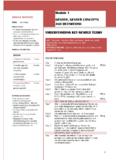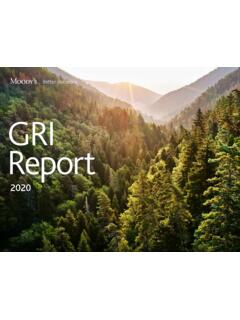Transcription of CONSOLIDATED SET OF GRI SUSTAINABILITY REPORTING …
1 1 CONSOLIDATED SET OF GRI SUSTAINABILITY REPORTING STANDARDS 20162 IntroductionThis document contains the set of 36 GRI SUSTAINABILITY REPORTING Standards and the GRI Standards Glossary published in 2016. The full content of each Standard has been incorporated, including the original formatting and page numbering. Users can navigate to specific Standards using the table of that this document includes numerous internal links. After clicking on a link, use alt + left arrow to return to the previous view. ContentsUniversal Standards PDF page number GRI 101: Foundation 2016 004 GRI 102: General Disclosures 2016 033 GRI 103: Management Approach 2016 077 CONSOLIDATED Set of GRI SUSTAINABILITY REPORTING Standards3 Topic-specific Standards GRI 200: economic 201: economic Performance 090 202: Market Presence 104 203: Indirect economic Impacts 114 204: Procurement Practices 122 205: Anti-corruption 130 206: Anti-competitive Behavior 141 GRI 300: Environmental 301: Materials 149 302: Energy 158 303: Water 172 304: Biodiversity 182 305: Emissions 194 306: Effluents and Waste 214 307: Environmental Compliance 227 308: Supplier Environmental Assessment 234 GRI 400.
2 Social 401: Employment 244 402: Labor/Management Relations 255 403: Occupational Health and Safety 263 404: Training and Education 276 405: Diversity and Equal Opportunity 287 406: Non-discrimination 296 407: Freedom of Association and Collective Bargaining 304 408: Child Labor 312 409: Forced or Compulsory Labor 321 410: Security Practices 329 411: Rights of Indigenous Peoples 337 412: Human Rights Assessment 346 413: Local Communities 358 414: Supplier Social Assessment 370 415: Public Policy 380 416: Customer Health Safety 388 417: Marketing and Labeling 398 418: Customer Privacy 408 419: Socioeconomic Compliance 416 GRI Standards Glossary 424 CONSOLIDATED Set of GRI SUSTAINABILITY REPORTING Standards GRI101 GRI 101: FOUNDATION 20162 ResponsibilityThis Standard is issued by the Global SUSTAINABILITY Standards Board (GSSB).
3 The full set of GRI Standards can be downloaded at Any feedback on the GRI Standards can be submitted to for the consideration of the 101: Foundation applies to any organization that wants to use the GRI Standards to report about its economic , environmental, and/or social impacts. Therefore, this Standard is applicable to: an organization that intends to prepare a SUSTAINABILITY report in accordance with the GRI Standards; or an organization that intends to use selected GRI Standards, or parts of their content, to report on impacts related to specific economic , social, and/or environmental topics ( , to report on emissions only).GRI 101 can be used by an organization of any size, type, sector, or geographic referencesThis Standard is to be used together with the most recent versions of the following documents.
4 GRI 102: General DisclosuresGRI 103: Management Approach GRI Standards GlossaryIn the text of this Standard, terms defined in the Glossary are dateThis Standard is effective for reports or other materials published on or after 1 July 2018. Earlier adoption is encouraged. About this StandardContentsIntroduction 3 A. Background on SUSTAINABILITY REPORTING 3B. Overview of the GRI SUSTAINABILITY REPORTING Standards 3C. Using this Standard 5 GRI 101: Foundation 71. REPORTING Principles 72. Using the GRI Standards for SUSTAINABILITY REPORTING 173. Making claims related to the use of the GRI Standards 21 Key Terms 27 GRI 101: Foundation 20163 GRI 103 GRI 102 Topic-specificStandardsUniversal StandardsStarting point for using the GRI StandardsGRI 101 FoundationGeneral DisclosuresManagement ApproachTo report contextual information about an organizationTo report the management approach for each material topicSelect from these to report specific disclosures for each material topicGRI 300 EnvironmentalGRI 400 SocialGRI 200 EconomicFigure 1 Overview of the set of GRI StandardsA.
5 Background on SUSTAINABILITY REPORTING In 1987, the World Commission on Environment and Development set out an aspirational goal of sustainable development describing it as development which meets the needs of the present without compromising the ability of future generations to meet their own needs. 1 Through their activities and relationships, all organizations make positive and negative contributions toward the goal of sustainable development. Organizations therefore have a key role to play in achieving this REPORTING , as promoted by the GRI Standards, is an organization s practice of REPORTING publicly on its economic , environmental, and/or social impacts, and hence its contributions positive or negative towards the goal of sustainable this process, an organization identifies its significant impacts on the economy, the environment, and/or society and discloses them in accordance with a globally-accepted standard.
6 The GRI Standards create a common language for organizations and stakeholders, with which the economic , environmental, and social impacts of organizations can be communicated and understood. The Standards are designed to enhance the global comparability and quality of information on these impacts, thereby enabling greater transparency and accountability of REPORTING based on the GRI Standards should provide a balanced and reasonable representation of an organization s positive and negative contributions towards the goal of sustainable development. The information made available through SUSTAINABILITY REPORTING allows internal and external stakeholders to form opinions and to make informed decisions about an organization s contribution to the goal of sustainable development.
7 B. Overview of the GRI SUSTAINABILITY REPORTING Standards The GRI SUSTAINABILITY REPORTING Standards (GRI Standards) are designed to be used by organizations to report about their impacts on the economy, the environment, and/or society. Using the GRI Standards as a set to prepare a SUSTAINABILITY reportThe GRI Standards are structured as a set of interrelated standards. They have been developed primarily to be used together to help an organization prepare a SUSTAINABILITY report which is based on the REPORTING Principles and focuses on material topics. Introduction1 World Commission on Environment and Development. 'Our Commonn Future'. Oxford: Oxford University Press, 1987 GRI 101: Foundation 20164 Preparing a report in accordance with the GRI Standards demonstrates that the report provides a full and balanced picture of an organization s material topics and related impacts, as well as how these impacts are managed.
8 A report in accordance with the GRI Standards can be produced as a stand-alone SUSTAINABILITY report, or can reference information disclosed in a variety of locations and formats ( , electronic or paper-based). Any report prepared in accordance with the GRI Standards is required to include a GRI content index, which is presented in one location and includes the page number or URL for all disclosures reported. See clause in this Standard and Disclosure 102-55 in GRI 102: General selected GRI Standards, or parts of their content, to report specific informationAn organization can also use selected GRI Standards, or parts of their content, to report specific information, provided that the relevant Standards are referenced correctly.
9 See Section 3 for more detail on using and referencing the GRI of the StandardsThe GRI Standards are divided into four series:Series Description Universal Standards 100 series The 100 series includes three universal Standards:GRI 101: Foundation is the starting point for using the set of GRI Standards. GRI 101 sets out the REPORTING Principles for defining report content and quality. It includes requirements for preparing a SUSTAINABILITY report in accordance with the GRI Standards, and describes how the GRI Standards can be used and referenced. GRI 101 also includes the specific claims that are required for organizations preparing a SUSTAINABILITY report in accordance with the Standards, and for those using selected GRI Standards to report specific information.
10 GRI 102: General Disclosures is used to report contextual information about an organization and its SUSTAINABILITY REPORTING practices. This includes information about an organization s profile, strategy, ethics and integrity, governance, stakeholder engagement practices, and REPORTING 103: Management Approach is used to report information about how an organization manages a material topic. It is designed to be used for each material topic in a SUSTAINABILITY report, including those covered by the topic-specific GRI Standards (series 200, 300, and 400) and other material topics. Applying GRI 103 with each material topic allows the organization to provide a narrative explanation of why the topic is material, where the impacts occur (the topic Boundary), and how the organization manages the Standards 200 series ( economic topics) 300 series (Environmental topics) 400 series (Social topics)The 200, 300, and 400 series include numerous topic-specific Standards.







